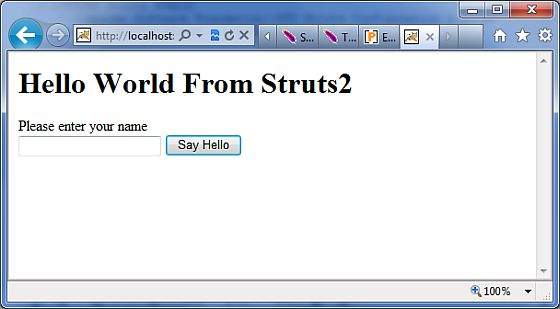(三)Struts2的Action(简单讲解版)
Actions是Struts2框架的核心,因为它们适用于任何MVC(Model View Controller)框架。 每个URL映射到特定的action,其提供处理来自用户的请求所需的处理逻辑。
但action还有另外两个重要的功能。 首先,action在将数据从请求传递到视图(无论是JSP还是其他类型的结果)方面起着重要作用。 第二,action必须协助框架确定哪个结果应该呈现在响应请求的视图中。
创建Action
Struts2中actions的唯一要求是必须有一个无参数方法返回String或Result对象,并且必须是POJO。如果没有指定no-argument方法,则默认是使用execute()方法。
你还可以扩展ActionSupport类,该类可实现六个接口,包括Action接口。Action的接口如下:
public interface Action {
public static final String SUCCESS = "success";
public static final String NONE = "none";
public static final String ERROR = "error";
public static final String INPUT = "input";
public static final String LOGIN = "login";
public String execute() throws Exception;
}
让我们来看看在Hello World示例中的action方法:
package cn.w3cschool.struts2;
public class HelloWorldAction{
private String name;
public String execute() throws Exception {
return "success";
}
public String getName() {
return name;
}
public void setName(String name) {
this.name = name;
}
}
为了说明action方法控制视图的要点,让我们对execute方法进行以下更改,并扩展ActionSupport类如下:
package cn.w3cschool.struts2;
import com.opensymphony.xwork2.ActionSupport;
public class HelloWorldAction extends ActionSupport{
private String name;
public String execute() throws Exception {
if ("SECRET".equals(name))
{
return SUCCESS;
}else{
return ERROR;
}
}
public String getName() {
return name;
}
public void setName(String name) {
this.name = name;
}
}
在这个例子中,我们在execute方法中使用一些逻辑来查看name属性。如果属性等于字符串“SECRET”,我们返回SUCCESS作为结果,否则我们返回ERROR作为结果。因为我们已经扩展了ActionSupport,所以我们可以使用String常量、SUCCESS和ERROR。 现在,让我们修改struts.xml文件如下:
<?xml version="1.0" encoding="UTF-8"?>
<!DOCTYPE struts PUBLIC
"-//Apache Software Foundation//DTD Struts Configuration 2.0//EN"
"http://struts.apache.org/dtds/struts-2.0.dtd">
<struts>
<constant name="struts.devMode" value="true" />
<package name="helloworld" extends="struts-default">
<action name="hello"
class="cn.w3cschool.struts2.HelloWorldAction"
method="execute">
<result name="success">/HelloWorld.jsp</result>
<result name="error">/AccessDenied.jsp</result>
</action>
</package>
</struts>
创建视图
让我们在你的eclipse项目的WebContent文件夹中创建下面的jsp文件HelloWorld.jsp。右键单击项目资源管理器中的WebContent文件夹,然后选择“New”> “JSP File”。如果返回结果是SUCCESS将调用此文件(这个字符串常量“success”是在Action接口中定义的):
<%@ page contentType="text/html; charset=UTF-8" %>
<%@ taglib prefix="s" uri="/struts-tags" %>
<html>
<head>
<title>Hello World</title>
</head>
<body>
Hello World, <s:property value="name"/>
</body>
</html>
如果action的结果是ERROR,即字符串常量为“error”,下面的文件将被框架调用。 以下是AccessDenied.jsp的内容:
<%@ page contentType="text/html; charset=UTF-8" %>
<%@ taglib prefix="s" uri="/struts-tags" %>
<html>
<head>
<title>Access Denied</title>
</head>
<body>
You are not authorized to view this page.
</body>
</html>
我们还需要在WebContent文件夹中创建index.jsp文件。此文件将用作初始的action URL,用户可以单击它以命令Struts 2框架调用HelloWorldAction类的execute方法并呈现HelloWorld.jsp视图。
<%@ page language="java" contentType="text/html; charset=ISO-8859-1"
pageEncoding="ISO-8859-1"%>
<%@ taglib prefix="s" uri="/struts-tags"%>
<!DOCTYPE html PUBLIC "-//W3C//DTD HTML 4.01 Transitional//EN"
"http://www.w3.org/TR/html4/loose.dtd">
<html>
<head>
<title>Hello World</title>
</head>
<body>
<h1>Hello World From Struts2</h1>
<form action="hello">
<label for="name">Please enter your name</label><br/>
<input type="text" name="name"/>
<input type="submit" value="Say Hello"/>
</form>
</body>
</html>
这样,没有改变web.xml文件的需求,所以我们可以使用前面在Hello World示例章节中创建的的web.xml文件。现在,我们准备好使用Struts 2框架运行我们的Hello World应用程序了。
执行应用程序
右键单击项目名称,然后单击“Export”>“WAR File”创建WAR文件。 然后在Tomcat的webapps目录中部署这个WAR文件。最后,启动Tomcat服务器并尝试访问URL http://localhost:8080/HelloWorldStruts2/index.jsp。显示的图示如下:

让我们输入一个单词为“SECRET”,你会看到如下页面:

现在输入除“SECRET”之外的任何词,你会看到如下页面:

创建多个Actions
你会需要频繁定义多个action来处理不同的请求,并为用户提供不同的URL,因此你将如下定义的不同类:
package cn.w3cschool.struts2;
import com.opensymphony.xwork2.ActionSupport; class MyAction extends ActionSupport{
public static String GOOD = SUCCESS;
public static String BAD = ERROR;
} public class HelloWorld extends ActionSupport{
...
public String execute()
{
if ("SECRET".equals(name)) return MyAction.GOOD;
return MyAction.BAD;
}
...
} public class SomeOtherClass extends ActionSupport{
...
public String execute()
{
return MyAction.GOOD;
}
...
}
你将如下在struts.xml文件中的配置这些action:
<?xml version="1.0" encoding="UTF-8"?>
<!DOCTYPE struts PUBLIC
"-//Apache Software Foundation//DTD Struts Configuration 2.0//EN"
"http://struts.apache.org/dtds/struts-2.0.dtd">
struts>
<constant name="struts.devMode" value="true" />
<package name="helloworld" extends="struts-default">
<action name="hello"
class="cn.w3cschool.struts2.HelloWorld"
method="execute">
<result name="success">/HelloWorld.jsp</result>
<result name="error">/AccessDenied.jsp</result>
</action>
<action name="something"
class="cn.w3cschool.struts2.SomeOtherClass"
method="execute">
<result name="success">/Something.jsp</result>
<result name="error">/AccessDenied.jsp</result>
</action>
</package>
</struts>
正如你在上面的例子中看到的,action的结果SUCCESS和ERROR是重复的。为了解决这个问题,建议您创建一个包含结果的类。
(三)Struts2的Action(简单讲解版)的更多相关文章
- J2EE进阶(三)struts2 <s:action>标签的用法
J2EE进阶(三)struts2 <s:action>标签的用法 前言 使用action标签,可以允许在jsp页面中直接调用Action,(类似AJAX页面调用)在调用Action时候,可 ...
- (四)Struts2的Action(深入讲解版)
Struts2的Action 开发者需要提供大量的Action,并在struts.xml中配置Action.Action类里包含了对用户请求的处理逻辑,因为我们也称Action为业务控制器. 一.编写 ...
- Struts2大约Action系统培训6大约action的接受三个参数的方法
我们知道,action在web它在控制器的发展起到了一定作用,通过接收client来到参数,运行不同的模块只实现运营,因此,接收参数是非常重要的组成部分,有接收到的参数的仅前端.操作权限运行数据库后端 ...
- struts2的action访问servlet API的三种方法
学IT技术,就是要学习... 今天无聊看看struts2,发现struts2的action访问servlet API的三种方法: 1.Struts2提供的ActionContext类 Object g ...
- Struts2中Action接收参数的方法主要有以下三种:
Struts2中Action接收参数的方法主要有以下三种: 1.使用Action的属性接收参数(最原始的方式): a.定义:在Action类中定义属性,创建get和set方法: b.接 ...
- struts2开发action 的三种方法以及通配符、路径匹配原则、常量
struts2开发action 的三种方法 1.继承ActionSupport public class UserAction extends ActionSupport { // Action中业务 ...
- Struts2之Action
Struts2之Action MVC模式中需要有一个控制器来负责浏览器与服务器之间的通信,实现用户与服务器的交互.在Struts2框架中实现这一功能的是Action,它是整个框架最核心的部分.Acti ...
- 简单讲解iOS应用开发中的MD5加密的相关使用
简单讲解iOS应用开发中的MD5加密的相关使用 作者:文顶顶 字体:[增加 减小] 类型:转载 时间:2015-12-19 我要评论 这篇文章主要介绍了iOS应用开发中的MD5加密的相关使用, ...
- [struts2学习笔记] 第五节 编写struts2的action代码
本文地址:http://blog.csdn.net/sushengmiyan/article/details/40479299 官方文档: http://struts.apache.org/relea ...
随机推荐
- 使用hive增量更新
目录 1.增量更新 2.对第一种情况 2.1.准备工作 2.2.更新数据 3.对第二种情况 3.1.准备工作 3.2.方法1 3.3.方法2 参考文末文章,加上自己的理解. 1.增量更新 有一个 ba ...
- JS相关基础
1. ES5和ES6继承方式区别 ES5定义类以函数形式, 以prototype来实现继承 ES6以class形式定义类, 以extend形式继承 2. Generator了解 ES6 提供的一种异步 ...
- 处理ios键盘弹出按钮点击click失效
用ontouchstart绑定事件即可,然后用 document.activeElement.blur();让键盘收起 this.value = value.replace(/\s/g, " ...
- 鸿蒙的js开发部模式16:鸿蒙布局Grid网格布局的应用一
鸿蒙入门指南,小白速来!从萌新到高手,怎样快速掌握鸿蒙开发?[课程入口]目录:1.Grid简介2.使用Grid布局实现的效果3.grid-row-gap和grid-colunm-gap属性4.< ...
- 如何使用irealtime.js实现一个基于websocket的同步画板
同步画板演示 同时打开2个tab,分别在画布上写下任意内容,观察演示结果,同时可设置画笔颜色及线条宽度.演示地址 初始化画布 <canvas id="drawBoard" w ...
- close() 和fluse()区别
1.close()默认包含了一次flush()操作,关闭之后,就不能再写入了. 2.flush()刷新,flush()之后,可以接着写入. 3.缓冲区默认大小是8192字节,如果小于8192字节,不会 ...
- 【不在混淆的C】指针函数、函数指针、回调函数
一.指针函数 函数的返回值是指针类型. int* fun(int a,int b); 指针函数使用: 返回字符串 这里要注意,"1234567890abc"是字符串常量,*p指向的 ...
- MYSQL bin_log 开启及数据恢复
参考博客: A:https://www.jianshu.com/p/55b0d52edca2 B:https://www.cnblogs.com/martinzhang/p/3454358.html ...
- JUnit5学习之八:综合进阶(终篇)
欢迎访问我的GitHub https://github.com/zq2599/blog_demos 内容:所有原创文章分类汇总及配套源码,涉及Java.Docker.Kubernetes.DevOPS ...
- 检查字符串是否包含另一串字符串(c++)
在c++中检查字符串是否包含另一串字符串,这个本来是我做过的一个算法题,不过最近刚好有个需求让我想到了这个题,就在此记录一下! 使用std::string::findfunction string s ...
